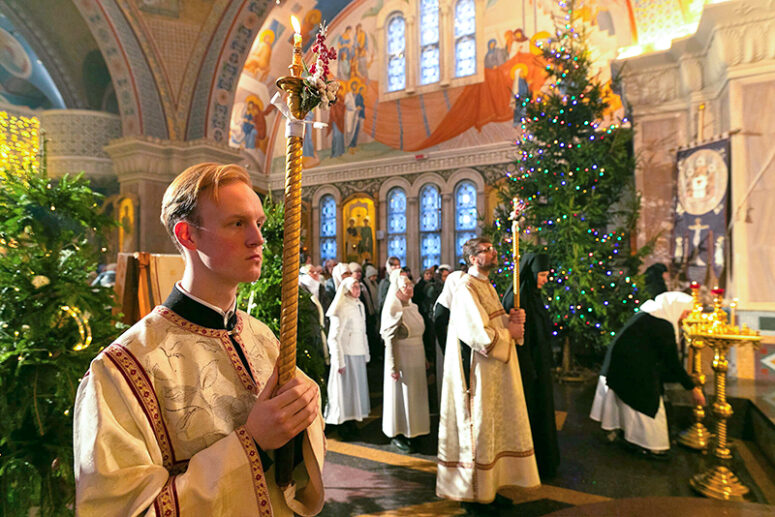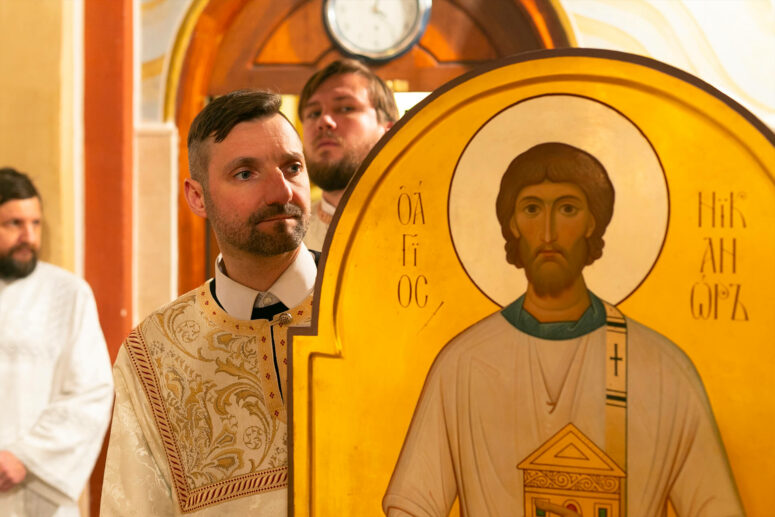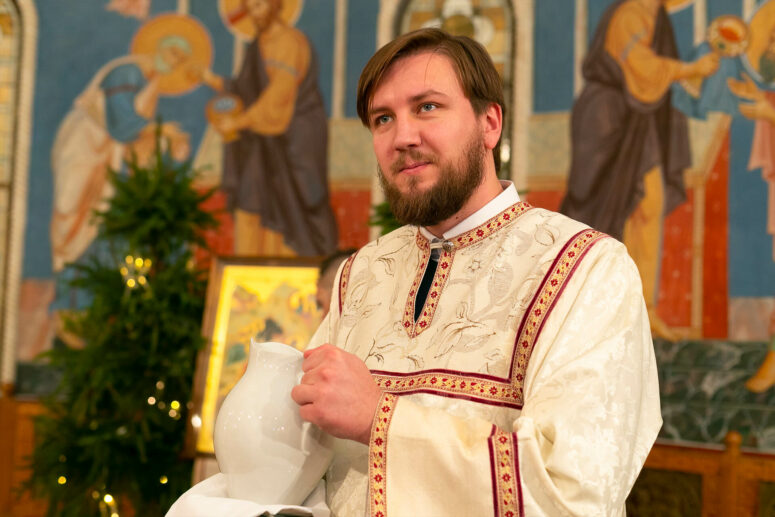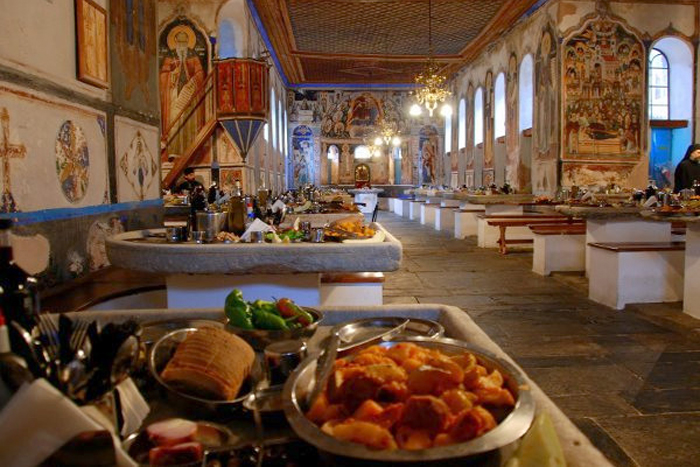
The ministry of the altar server has gone through several stages of development. The word ponomar, used in reference to altar servers in the Russian Orthodox Church, traces its roots to the Greek paramonarios, literally meaning “a doorkeeper” and combining two meanings, para – near and meno – to wait. This word perfectly describes the essence of the altar server’s ministry in its original form of a warden, guarding the safety of an entire church community or relic. In its modern form, however, the altar server’s ministry mostly consists in assisting the clergy during divine services and in daily activities. These significant changes resulted in a number of issues related to the canonical status of the altar server’s ministry in the Orthodox Church.
Ancient Service
The first written source mentioning altar servers was the second canon of the Council of Chalcedon (451), according to which a bishop paying someone for fulfilling certain church responsibilities (including those of an altar server) was subject to defrocking.
The origins of the altar server’s ministry, however, go back to a much earlier period, namely, to the times of persecution (before 313). In the early Christian Church, the main duty of an altar server was the unceasing guard of a church or a particular relic.
Standing at the entrance gates of churches, often located in catacombs, ancient altar servers kept watch to make sure that no excommunicated, heretics, gentiles or other outsiders would enter. This was extremely important in the times of persecution, when Christians were forced to hide their faith from the spies of the Roman Empire trying to sneak into Christian services, memorize the faces and names of Christians and deliver them up to the authorities.

Altar servers’ duties also required their constant presence in sacred places (for example, at the Bethlehem cave) in order to protect them from sacrilege and to help the pilgrims.
With the end of the persecution against Christians, the main duties of altar servers shifted towards maintaining order in the church and preparing it for worship.
Modern Ministry
Modern altar servers are responsible for the timely lighting of lamps and candles in the altar and on the solea; preparing vestments, censers and materials for worship; carrying candles during services; wiping the lips of the laity during Communion; helping the priest during the sacraments and occasional offices; if possible and if necessary, performing duties of a reader, singer and bell ringer.
During the divine service, an altar server wears a sticharion, a liturgical garment reminiscent of the Old Testament tunic. Sometimes, with a bishop’s blessing, an altar server may also wear a cassock, the everyday vestment of the Orthodox monastics and clergy. A bishop can also reward an altar server for special merits or years of dedicated work, with the right to wear an orarion in the same way as a subdeacon.

In the ancient Church, altar servers were ordained, but in modern practice a priestly blessing is sufficient for a layman to begin serving in the altar. This generally means that altar servers remain laymen, which explains the rare exceptions when the traditions of certain Local Churches allow women to serve in the altar.
In the persecuted Russian Church of the 20th century, the altar servers’ duties were assigned to elderly nuns (more often schema nuns) due to the absence of other candidates. In the modern Alexandrian Church, young girls (of primary school age) can be seen serving in the altar.

Canonical and Practical Issues of Contemporary Altar Server’s Ministry
There are several issues related to the correct name and the canonical status of the modern altar server’s ministry that appear controversial at first glance.
For example, in the Russian Empire before the 19th century, the term “altar server” was applied exclusively to clergy.
However, the concept of the altar server was extended with time, due to the fact that many clerical functions, both statutory (for example, a candle bearer, reader, canonarch) and non-statutory (bell ringer, prosphora-baker, candle maker, etc.) are currently performed by modern altar servers, whose original duties have become things of the distant past. This leaves some questions unanswered regarding the canonical status of the seemingly archaic office of the ancient “door keeper”.
As mentioned above, altar servers are not ordained by the bishop and remain laymen. Rule 69 of the Sixth Ecumenical Council reads, “Let it not be permitted to anyone among all the laity to enter within the sacred altar…” It turns out that a modern altar server cannot enter the altar. Even more so, this applies to women, “It is inappropriate for a woman to enter the altar ” (Canon 44 of the Laodicean Council).

Logically speaking, laymen are also not allowed to put on sacred robes, since the vesting happens in the altar, and besides they are prescribed for specific members of clergy, and not for laymen. This makes the rare usage of oraria by altar servers discussed in the beginning of the article even less canonical, since it is not permitted be worn even by the minor clergy, “The subdeacons, readers or singers have no right to wear an orarium…” (rule 22-23 of the Laodicean Council).
We know that all the rules of all the Councils must be observed, “We pronounce it just and right that the Canons promulgated by the Holy Fathers, in each and every Council down to the present time, continue in full force and effect.” (Canon 1 of the 4th Ecumenical Council). But, at the same time, “The sabbath was made for humankind, and not humankind for the sabbath” (Mark 2: 23-27). Proceeding from the principle of pastoral oeconomy (Greek: οἰκονομία, oikonomia) and for the benefit and welfare of the Church, there may be different traditions that are not canonically formalized. This allows altar servers to fulfill their ministry in the altar and put on ecclesiastical garments.





Dear Reader John,
Very interesting! I can’t shake the impression that this was a snippet of a larger work, it seems somewhat truncated. Am I correct, is there a more detailed paper you have written on the subject/
In Christ,
Sdn. Joseph
Dear Joseph,
Many thanks! There is no other paper. I agree that there is much more that could be added to this matter. Which is probably the reason for your impression. But, unfortunately, the authors of our blog must comply with a certain size of articles. In some cases, that size is not enough.
May God bless you and your loved ones!
Reader John
Very interesting. Thank you!
Can you say something about the required age of altar servers? I’ve heard it said that the use of children as altar servers is a fairly modern practice, and that in antiquity it would have been adults only.